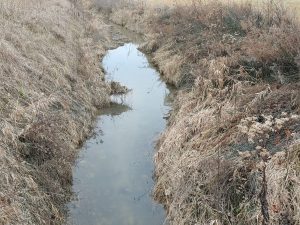Funding and Phosphorus Reduction
By Dusty Sonnenberg, CCA, Ohio Field Leader: a project of the Ohio Soybean Council and soybean checkoff.
Analyzing the cost benefit ratio is a regular management function in agriculture. As farmers make decisions regarding the implementation of best management practices and fertilizer application rates, there is an economic benefit analysis that must be considered. The same applies as the government makes decisions regarding the allocation of resources to phosphorus reduction in the Western Lake Erie Basin. The USEPA is working to develop alternative approaches to achieving nutrient reduction without regulation. Studies have been conducted in the smaller yet similar and more intensely monitored East Fork Watershed in Southern Ohio to develop modeling by conducting bioassessments to determine impact and target levels for excess nutrients.
Watershed action planning involves evaluating the cost of reduction of total phosphorus (TP) levels. “In the modeled watershed, to make the improvements to waste water treatment plants (WWTP), to achieve a 1% reduction in phosphorus (P) load it would cost $5.4 million dollars. The same P reduction could be achieved with credits from cover crops for $425,000 dollars over only 7,900 acres,” said Chris Nietch, Research Ecologist with the USEPA. “Put another way, for the same cost to upgrade waste water treatment plants ($5.4 million), cover crops could be planted on all the row crop fields in the modeled watershed, (104,000 acres), assuming the median removal efficiency of 50% effectiveness is realized.”
Working the modeling out in further planning, an uncertain variable is the efficiency of cover crops at removing P. “If we account for the uncertainty in the cover crop effectiveness, then the TP problem cannot be fixed with only one BMP alone, the plan would need to include wetlands, filter strips, and cover crops,” said Nietch. “The estimated annual cost to keep the TP loading in check with this modeled watershed is between $3.5 million to $8 million annually.” (Which calculates to $250,000-$600,000/HUC12 for correlation purposes. A HUC12 is a hydrologic unit of measure describing a sub-watershed level that captures tributary systems)
For the example in the East Fork Watershed, it will take 1,000 acres of wetlands, (which correlates to 1 acre of wetland treating every 100 acres in production), 2,600 acres of filter strips, and over 40% of all the tillable acres (43,000 acres) to have cover crops at an annual cost just under $6 million. (This would also take care of at least half of the total nitrogen (TN) problem depending on efficiency.) “For context, the cost for these agricultural BMP’s equals 20% of the annual row crop revenue in the watershed ($30 million),” said Nietch. “Each drinking water treatment plant in the watershed spends an average of $650,000 annually for granular activated carbon to treat the cyanobacteria and keep the drinking water safe.”
There are obvious differences in total area, topography, and land use, between the Maumee River Watershed and the East Fork Watershed, however the modeling allows researchers to reach calculated conclusions for addressing the P loading concerns. “The State of Ohio has proposed spending $85 million on the Maumee River Watershed to address these issues,” said Nietch. “Based on the total area, that comes out to roughly $250,000/HUC12. That number corresponds with the low end estimate of our assessment for the East Fork Watershed.”